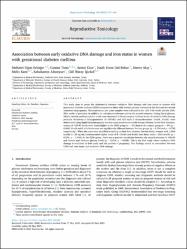| dc.contributor.author | Erbağcı, Mehmet Oğuz | |
| dc.contributor.author | Tuna, Gamze | |
| dc.contributor.author | Bekar, Nazlı Ecem Dal | |
| dc.contributor.author | Akış, Merve | |
| dc.contributor.author | Kant, Melis | |
| dc.contributor.author | Altunyurt, Sabahattin | |
| dc.contributor.author | İşlekel, Gül Hüray | |
| dc.date.accessioned | 2022-06-29T06:43:21Z | |
| dc.date.available | 2022-06-29T06:43:21Z | |
| dc.date.issued | 2021 | en_US |
| dc.identifier.issn | 0890-6238 - 1873-1708 | |
| dc.identifier.uri | https://doi.org/10.1016/j.reprotox.2021.05.009 | |
| dc.identifier.uri | https://hdl.handle.net/20.500.12462/12369 | |
| dc.description | Akış, Merve (Balikesir Author) | en_US |
| dc.description.abstract | This study aims to assess the relationship between oxidative DNA damage and iron status in women with gestational diabetes mellitus (GDM) compared to those with normal glucose tolerance in the first and the second trimesters of pregnancy. Maternal serum and urine samples were collected in the 11th-14th weeks and the 24th28th weeks of gestation. In addition to oral glucose tolerance test in the second trimester, fasting blood glucose, HbA1c, ferritin and hemoglobin levels were measured in blood samples. Urinary levels of oxidative DNA damage products 8-hydroxy-2 '-deoxyguanosine (8-OH-dG) and 8,5 '-cyclo-2 '-deoxyadenosines (S-cdA, R-cdA) were determined using liquid chromatography-tandem mass spectrometry with isotope-dilution. In the first trimester, urinary 8-OH-dG levels were found higher in the GDM group (n = 33) than in the control group (n = 84) (p = 0.006). R-cdA and S-cdA levels were not significantly different between the two groups (p = 0.794 and p = 0.792 respectively). When the cases were stratified according to their first trimester ferritin levels, women with 50th centile (>130 ng/mL) demonstrated higher levels of 8-OH-dG and R-cdA than those under <50th centile (p = 0.034, p = 0.009). In the GDM group, there was a positive correlation between the second trimester 8-OH-dG and ferritin and 1st-hour glucose levels (p = 0.014, p = 0.020). This is the first study where oxidative DNA damage is evaluated in both early and late periods of pregnancy. Our findings reveal an association between GDM and iron status and oxidative DNA damage. | en_US |
| dc.description.sponsorship | Dokuz Eylul University KB.SAG.013 | en_US |
| dc.language.iso | eng | en_US |
| dc.publisher | Pergamon-Elsevier Science Ltd | en_US |
| dc.relation.isversionof | 10.1016/j.reprotox.2021.05.009 | en_US |
| dc.rights | info:eu-repo/semantics/openAccess | en_US |
| dc.subject | Gestational Diabetes Mellitus | en_US |
| dc.subject | Oxidative Stress | en_US |
| dc.subject | Oxidative DNA Damage | en_US |
| dc.subject | Iron | en_US |
| dc.subject | Ferritin | en_US |
| dc.subject | 8-hydroxy-2-deoxyguanosine | en_US |
| dc.subject | 8,5’-cyclo-2’-deoxyadenosines | en_US |
| dc.title | Association between early oxidative DNA damage and iron status in women with diabetes mellitus | en_US |
| dc.type | article | en_US |
| dc.relation.journal | Reproductive Toxicology | en_US |
| dc.contributor.department | Tıp Fakültesi | en_US |
| dc.contributor.authorID | 0000-0002-1556-4920 | en_US |
| dc.contributor.authorID | 0000-0002-5338-7355 | en_US |
| dc.contributor.authorID | 0000-0001-7621-7503 | en_US |
| dc.identifier.volume | 103 | en_US |
| dc.identifier.startpage | 171 | en_US |
| dc.identifier.endpage | 180 | en_US |
| dc.relation.publicationcategory | Makale - Uluslararası Hakemli Dergi - Kurum Öğretim Elemanı | en_US |


















